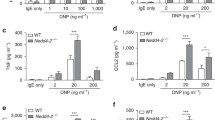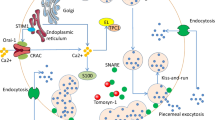Abstract
Immunoglobulin E (IgE) plays a central role in the pathogenesis of allergic diseases by interacting with two membrane receptors: high-affinity FcεRI and low-affinity FcεRII (CD23). Allergen-induced IgE-occupied EcεRI aggregation on the mast cell or basophil cell surface leads to the activation of intracellular signaling events and eventually the release of pre-formed and de novo synthesized inflammatory mediators. The role of FcεRII in allergic diseases has been proposed to include regulation of IgE synthesis, enhanced histamine release from basophils, and a contribution to Ag-IgE complex presentation but the exact function of CD23 remains poorly understood. This review summarizes some new developments in IgE Fc-receptor studies with an emphasis on regulation of FcεRI expression and signal transduction, including monomeric IgE, lipid raft segregation, and some recently identified negative regulators. A better understanding of signaling events following IGE FcR aggregation will shed new light on how allergy patients might be treated more safely and effectively.
Similar content being viewed by others
References
Daeron M: Fc receptor biology. Ann Rev Immunol 1997; 15:2203–234.
Nadler MJ, Matthews SA, Turner H, Kinet JP: Signal transduction by the high-affinity immunoglobulin E receptor FcεRI: coupling form to function. Adv Immunol 2001; 76:325–355.
Parravicini V, Gadina M, et al: Fyn kinase initiates complementary signals required for IgE-dependent mast cell degranulation. Nat Immunol 2002; 3: 741–748.
Galli SJ, Kalesinikoff J, Grimbaldeston MA, Piliponsky AM, Williams CM, Tsai M: Mast cells as “tunable” effectors and immunoregulatory cells: recent advances. Annu Rev Immunol 2005; 23:749–786.
Novak N, Kraft S, Bieber T: IgE receptors Curr Opin Immunol 2001; 13:721–726.
Mukai K, Matsuoka K, Taya C, et al: Basophils play a critical role in the development of IgE-mediated chronic allergic inflammation independently of T cells and mast cells. Immunity 2005; 23:191–202.
Schroeder JT, Bieneman AP, Xiao H, et al: TLR9- and Fcepsilon RI-mediated responses oppose one another in plasmacytoid dendritic cells by down-regulating receptor expression. J Immunol 2005; 175:5724–5731.
Gounni AS, Wellemans V, Yang J, et al: Human airway smooth muscle cells express the high affinity receptor for IgE (Fc epsilon RI): a critical role of Fc epsilon RI in human airway smooth muscle cell function. J Immunol 2005; 175: 2613–2621.
Donnadieu E, Jouvin MH, Rama S, et al: Competing functions encoded in the allrgy-associated F(c)epsilon-RIbeta gene. Immunity 2003; 18:665–674.
Fiebiger E, Tortorella D, Jouvin MH, Kinet JP, Ploegh HL: Cotranslational endoplasmic reticulum assembly of Fc{varepsilon}RI controls the formation of functional IgE-binding receptors. J Exp Med 2005;201:267–277.
Nishiyama C, Akizawa Y, Nishiyama M et al: Poly-morphisms in the Fc epsilon RI beta promoter region affecting transcription activity: a possible promoter-dependent mechanism for association between Fc epsilon RI beta and atopy. J Immunol 2004; 173: 6458–6464.
Hasegawa M, Nishiyama C, Nishiyama M, et al: A novel −66T/C polymorphism in Fc epsilon RI alpha-chain promoter affecting the transcription activity: possible relationship to allergic diseases. J Immunol 2003; 171:1927–1933.
Bobrzynski T, Fux M, Vogel M, Stadler MB, Stadler BM, Miescher SM: A high-affinity natural autoantibody from human cord blood defines a physiologically relevant epitope on the FcepsilonRIalpha. J Immunol 2005; 175:6589–6596.
Bruhus P, Fremont S, Daeron M: Regulation of allergy by Fc receptors. Curr Opin Immunol 2005; 17:662–669.
Kawakami T, Galli SJ: Regulation of mast-cell and basophile function and survival by IgE. Nat Rev Immunol 2002; 10:773–786.
Kitaura J, Xiao W, Maeda-Yamamoto M, Kawakami Y, Lowell CA, Kawakami T: Early divergence of Fc epsilon receptor I signals for receptor up-regulation and internalization from degranulation, cytokine production, and survival. J Immunol 2004; 173;4317–4323.
Lam V, Kalesnikoff J, Lee CW, et al IgE alone stimulates mast cell adhesion to fibronectin via pathways similar to those used by IgE + antigen but distinct from those used by Steel factor. Blood 2003; 102:1405–1413.
Kitaura J, Kinoshita T, Matsumoto M, et al: IgE- and IgE+Ag-mediated mast cell migration in an autocrine/paracrine fashion. Blood 2005; 105:322–3229.
Kitaura J, Song J, Tsai M, et al: Evidence that IgE molecules mediate a spectrum of effects on mast cell survival and activation via aggregation of the FcepsilonRI. Proc Natl Acad Sci USA 2003; 100: 12911–12916.
James LC, Roversi P, Tawfik DS: Antibody multispecificity mediated by conformational diversity. Science 2003; 299:1362–1367.
Schweitzer-Stenner R, Pecht I: Death of a dogma or enforcing the artificial: monomeric IgE binding may initiate mast cell response by inducing its receptor aggregation. J Immunol 2005; 174;4461–4464.
Holowka D, Gosse JA, Hammond AT, et al: Lipid segregation and IgE receptor signaling: a decade of progress. Biochim Biophys Acta 2005; 1746:252–259.
Young RM, Zheng X, Holowka D, Baird B: Reconstitution of regulated phosphorylation of FcepsilonRI by a lipid raft-excluded protein-tyrosine phosphatase. J Biol Chem 2005; 280:1230–1235.
Gosse JA, Wagenknecht-Wiesner A, Holowka D, Baird B: Transmembrane sequences are determinants of immunoreceptor signaling. J Immunol 2005; 175: 2123–2131.
Wu M, Holowka D, Craighead HG, Baird B: Visualization of plasma membrane compartmentalization with patterned lipid bilayers. Proc Natl Acad Sci USA 2004; 101:13798–13803.
Lesourne R, Fridman WH, Daeron M: Dynamic interactions of Fc gamma receptor HB with filamin-bound SHIPI amplify filamentous actin-dependent negative regulation of Fc epsilon receptor I signaling. J Immunol 2005; 174:1365–1373.
Larson DR, Gosse JA, Holowka DA, Baird BA, Webb WW: Temporally resolved interactions between antigen-stimulated IgE receptors and Lyn kinase on living cells. J Cell Biol 2005; 171:527–536.
Gimborn K, Lessmann E, Kuppig S, Krystal G, Huber M: SHIP down-regulates Fcepsilon R1-induced degranulation at supraoptimal IgE or antigen levels. J Immunol 2005; 174:507–516.
Xiao W, Nishimoto H, Hong H, et al: Positive and negative regulation of mast cell activation by Lyn via the Fcepsilon RI. J Immunol 2005; 175:6885–6892.
Furumoto Y, Nunomura S, Terada T, Rivera J, Ra C: The EcepsilonRIbeta immunoreceptor tyrosine-based activation motif exerts inhibitory control on MAPK and IkappaB kinase phosphorylation and mast cell cytokine production. J Biol Chem 2004; 279:49177–49187.
Xu Y, Harder KW, Huntington ND, Hibbs ML, Tarlinton DM: Lyn tyrosine kinase: accentuating the positive and the negative. Immunity 2005; 22:9–18.
Hernandez-Hansen V, Smith AJ, Surviladze Z, et al: Dysregulated FcepsilonRI signaling and altered Fyn and SHIP activities in Lyn-deficient mast cells. J Immunol 2004; 173:100–112.
Odom Gomez G, Kovarova M, et al: Negative regulation of immunoglobulin E-dependent allergic responses by Lyn kinase. J Exp Med 2004; 199:1491–1502.
Simon M, Vanes L, Geahlen RL, Tybulewicz VL: Distinct roles for the linker region tyrosines of Syk in FcepsilonRI signaling in primary mast cells. J Biol Chem 2005; 280:4510–4517.
Kettner A, Kumar L, Anton IM, et al: WIP regulates signaling via the high affinity receptor for immunoglobulin E in mast cells. J. Exp Med 2004; 199:357–368.
Pasquier B, Launay P, Kanamaru Y, et al: Identification of FcalphaRI as an inhibitory receptor that controls inflammation: dual role of FcRgamma ITAM. Immunity 2005; 22:31–42.
Tam SY, Tsai M, Snouwaert JN, et al: RabGEF1 is a negative regulator of mast cell activation and skin inflammation. Nat Immunol 2004; 5:844–852.
D'Amato G: Role of anti-IgE monoclonal antibody (omalizumab) in the treatment of bronchial asthma and allergic respiratory disease. Eur J Pharmacol 2006; 533: 302–307.
Bousquet J, Cabrera P, Berkman N, et al: The effect of treatment with omalizumab an anti-IgE antibody, on asthma exacerbations and emergency medical visits in patients with severe persistent asthma. Allergy 2005; 60:302–308.
Zhu D, Kepley CL, Zhang M, Zhang K, Saxon A: A novel human immunoglobulin Fc gamma Fc epsilon bifunctional fusion protein inhibits Fc epislon RI-mediated degranulation. Nat Med 2002; 8:518–521.
Tam SW, Demissie S, Thomas D, Daeron M. A bispecific antibody against human IgE and human FcgammaRII that inhibits antigen-induced histamine release by human mast cells and basophils. Allergy 2004; 59: 772–780.
Hibbert RG, Teriete P, Grundy GJ, et al: The structure of human CD23 and its interactions with IgE and CD21. J Exp Med 2005; 202:751–760.
Puccetti A, Bason C, Simeoni S, et al: In chronic idiopathic urticaria autoantibodies against Fc epsilonRII/CD23 induce histamine release via eosinophil activation. Clin Exp Allergy 2005; 35:1599–1607.
Getahun A, Hjelm F, Heyman B: IgE enhances antibody and T cell responses in vivo via CD23+ B cells. J Immunol 2005; 175:1473–1482.
Poole JA, Meng J, Reff M, Spellman MC, Rosenwasser LJ: Anti-CD23 monoclonal antibody, lumiliximab, inhibited allergen-induced responses in antigen-presenting cells and T cells from atopic subjects. J Allergy Clin Immunol 2005; 116:780–788.
Author information
Authors and Affiliations
Corresponding author
Rights and permissions
About this article
Cite this article
Zhang, M., Murphy, R.F. & Agrawal, D.K. Decoding IgE Fc receptors. Immunol Res 37, 1–16 (2007). https://doi.org/10.1007/BF02686092
Issue Date:
DOI: https://doi.org/10.1007/BF02686092




